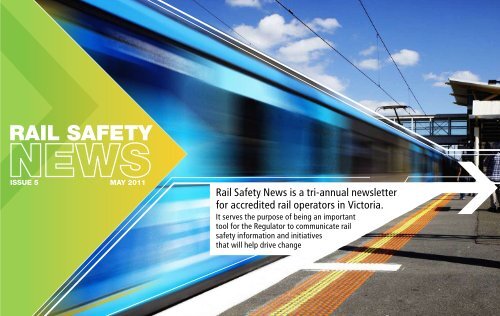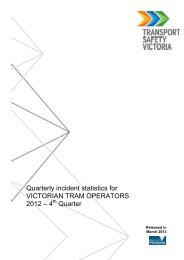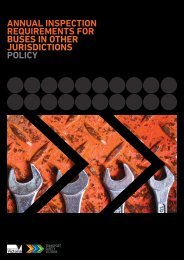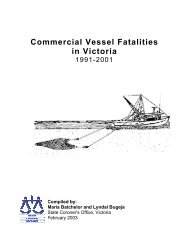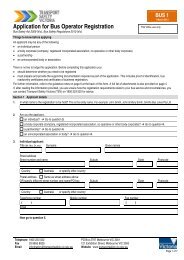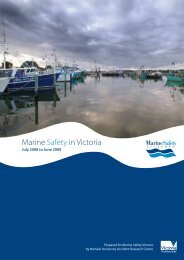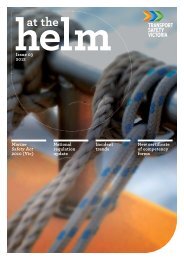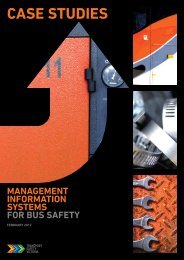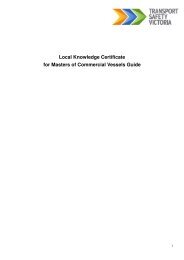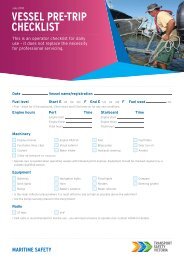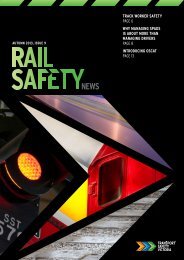Rail Safety News - Issue 5 - May 2011 - Transport Safety Victoria
Rail Safety News - Issue 5 - May 2011 - Transport Safety Victoria
Rail Safety News - Issue 5 - May 2011 - Transport Safety Victoria
Create successful ePaper yourself
Turn your PDF publications into a flip-book with our unique Google optimized e-Paper software.
RAIL SAFETY<br />
ISSUE 5 MAY <strong>2011</strong><br />
><br />
ISSUE 17 APRIL <strong>2011</strong> <strong>Rail</strong> <strong>Safety</strong> <strong>News</strong> is a tri-annual newsletter<br />
for accredited rail operators in <strong>Victoria</strong>.<br />
It serves the purpose of being an important<br />
tool for the Regulator to communicate rail<br />
safety information and initiatives<br />
that will help drive change
2<br />
Public <strong>Transport</strong> <strong>Safety</strong> <strong>Victoria</strong><br />
has changed!<br />
Marine <strong>Safety</strong> <strong>Victoria</strong> and Public <strong>Transport</strong> <strong>Safety</strong> <strong>Victoria</strong> came together as <strong>Transport</strong> <strong>Safety</strong> <strong>Victoria</strong> (TSV) from 1 July 2010.<br />
TSV is charged with the responsibility of regulating the safety of <strong>Victoria</strong>’s maritime, bus, rail and tram operations. The<br />
changes are an outcome of the <strong>Transport</strong> Integration Act 2010, which aims to establish a new framework for the provision<br />
of an integrated and sustainable transport system in <strong>Victoria</strong>.<br />
All staff email addresses reflect the change, with the userid being first name and<br />
last name separated by a full stop, and the domain name transportsafety.vic.gov.au<br />
(example john.fox@transportsafety.vic.gov.au).<br />
3<br />
Renewal of Memorandum<br />
of Understanding<br />
between the <strong>Safety</strong> Director<br />
and WorkSafe<br />
The Director, <strong>Transport</strong> <strong>Safety</strong> (<strong>Safety</strong><br />
Director) may enter into a memorandum of<br />
understanding (MOU) with other persons or<br />
bodies who have regulatory functions and<br />
powers that interact, or may interact, with the<br />
functions and powers of the <strong>Safety</strong> Director.<br />
An MOU between the <strong>Safety</strong> Director and<br />
WorkSafe <strong>Victoria</strong> was signed on 6 <strong>May</strong> 2010.<br />
The objective of this MOU is to record how<br />
both parties intend to cooperate in relation<br />
to the safety and regulation of the public<br />
transport system in <strong>Victoria</strong>.<br />
¼¼<br />
The MOU can be accessed in full at<br />
www.transportsafety.vic.gov.au<br />
TABLE OF<br />
CONTENTS
4<br />
Update on national rail safety regulator<br />
On 7 December 2009, the Council of Australian Governments (COAG)<br />
agreed to establish a national regulator for rail safety as part of COAG’s<br />
reform agenda to ‘deliver a seamless national economy’.<br />
Since then Australian regulators and representatives from each<br />
jurisdiction’s transport departments have been working to assist COAG<br />
to give effect to this decision. <strong>Transport</strong> <strong>Safety</strong> <strong>Victoria</strong> continues to<br />
provide input to ensure rail safety outcomes in <strong>Victoria</strong> and nationally<br />
are secured, including giving the <strong>Victoria</strong>n regulatory perspective on:<br />
• developing a national rail safety legislative framework,<br />
• policy analysis on drug and alcohol and fatigue management issues,<br />
and<br />
• a national partnership agreement that will implement the new<br />
regulator.<br />
TSV continues to work closely and cooperatively with the <strong>Victoria</strong>n<br />
Department of <strong>Transport</strong> and other jurisdictions to progress this national<br />
reform agenda going forward.<br />
TABLE OF<br />
CONTENTS
5<br />
<strong>Rail</strong> industry workshop: Applying the<br />
Contributing Factors Framework<br />
<strong>Transport</strong> <strong>Safety</strong> <strong>Victoria</strong> is holding a workshop for those interested<br />
in learning how to apply the Contributing Factors Framework (CFF).<br />
The session will include an overview of the CFF, followed by practical<br />
application of the framework to accident investigation case studies in a<br />
small group format.<br />
The CFF is a tool developed for the rail industry to assist in identifying<br />
the systemic safety issues which contribute to accidents. The CFF takes<br />
information already available from systemic investigation reports and<br />
turns this into data which can help to identify trends and patterns in<br />
safety deficiencies. This will enable rail organisations to better target<br />
safety initiatives that deal with the source of problems rather than<br />
the symptoms.<br />
The workshop is aimed towards those people working in rail who might<br />
be applying the CFF as part of their role – for example, investigators,<br />
analysts and other safety professionals. However, subject to places<br />
being available, anyone working in the rail industry who is interested in<br />
learning more about the CFF and how it is applied is welcome to attend.<br />
Workshop details:<br />
Date: 20 June <strong>2011</strong><br />
Time: 12:30pm – 4:30pm (a light lunch will be provided on arrival)<br />
Venue: 121 Exhibition Street<br />
RSVP: Friday 10 June <strong>2011</strong>, by email to:<br />
stacey.berhardt@transportsafety.vic.gov.au<br />
(please provide names of attendees and any special dietary<br />
requirements)<br />
TABLE OF<br />
CONTENTS
6<br />
Voluntary enforceable undertakings<br />
Following changes to the <strong>Transport</strong><br />
(Compliance and Miscellaneous) Act 1983 (Vic)<br />
on 1 July 2010, the Director, <strong>Transport</strong> <strong>Safety</strong><br />
(<strong>Safety</strong> Director) now has the power to accept<br />
a voluntary enforceable undertaking (VEU)<br />
from an accredited rail operator.<br />
A VEU is a voluntary promise by an<br />
operator to the <strong>Safety</strong> Director to<br />
carry out/not carry specific activities<br />
relating to a contravention/alleged<br />
contravention of the <strong>Rail</strong> <strong>Safety</strong> Act<br />
2006 (Vic).<br />
A VEU is offered by the rail operator,<br />
but may be initiated by either the<br />
operator or TSV. An operator cannot<br />
be compelled to sign a VEU and TSV<br />
cannot be compelled to accept one.<br />
If accepted by TSV, a VEU operates as<br />
an agreement between the operator<br />
and the <strong>Safety</strong> Director.<br />
An operator cannot vary or withdraw the<br />
undertaking without the consent of TSV. If TSV<br />
considers an undertaking has been breached,<br />
TSV may apply to the Magistrates’ Court for<br />
enforcement of the undertaking. If the Court<br />
agrees, the Court may:<br />
• order that the operator:<br />
• comply with the undertaking, or<br />
• take specified action to comply with<br />
the undertaking; or<br />
• make any other order it considers<br />
appropriate.<br />
It is an offence not to comply with a<br />
Magistrates’ Court order. For the 2010/11<br />
financial year, the maximum penalties<br />
applicable for this offence are $28,668 for<br />
individuals and $143,340 for companies.<br />
TABLE OF<br />
CONTENTS
7<br />
Legislation update<br />
On 1 July 2010, a range of important changes were made to the legislation administered by TSV:<br />
• integrated transport framework – <strong>Transport</strong><br />
Integration Act 2010 (Vic) is the new principal transport<br />
statute for <strong>Victoria</strong> establishing new charters for<br />
<strong>Victoria</strong>’s transport agencies aligned with the Act’s<br />
vision, objectives and principles. It establishes the<br />
new Director, <strong>Transport</strong> <strong>Safety</strong> bringing together safety<br />
regulation of rail and bus, with that of marine<br />
• <strong>Transport</strong> Act 1983 renamed – on 1 July 2010, the<br />
former <strong>Transport</strong> Act 1983 (Vic) was renamed, and is now<br />
known as the <strong>Transport</strong> (Compliance and Miscellaneous)<br />
Act 1983 (Vic). All references to the <strong>Transport</strong> Act 1983<br />
(Vic) are now to be read as references to the <strong>Transport</strong><br />
(Compliance and Miscellaneous) Act 1983 (Vic)<br />
• safety interface agreements – new requirements for<br />
rail and road parties to identify, assess and manage<br />
risks associated with rail-rail or rail-road interfaces.<br />
Agreed measures to control risks are to<br />
be implemented under ‘safety interface<br />
agreements’ entered into by the relevant<br />
parties (see new Division 2 Part 4 <strong>Rail</strong> <strong>Safety</strong><br />
Act 2006 (Vic))<br />
• enforceable undertakings – new powers for the<br />
Director, <strong>Transport</strong> <strong>Safety</strong> to accept written undertakings<br />
from an accredited rail operator in relation to any<br />
(alleged) contravention of a relevant safety law (see<br />
new Division 4B Subdivision 13 of the renamed <strong>Transport</strong><br />
Compliance and Miscellaneous Act 1983 (Vic)) [refer to<br />
Voluntary enforceable undertaking article]<br />
• adverse publicity order – new powers for a court to<br />
make an adverse publicity order for the commission of a<br />
relevant offence (see new s230FA <strong>Transport</strong> Compliance<br />
and Miscellaneous Act 1983 (Vic)).<br />
TABLE OF<br />
CONTENTS
8<br />
<strong>Rail</strong> Audit & Compliance Program<br />
From 1 July 2010 to date<br />
the TSV has conducted the<br />
following activities:<br />
• 8 National audits<br />
• 16 <strong>Safety</strong> audits<br />
• 54 Compliance inspections<br />
The activities that have been<br />
undertaken on both Accredited<br />
and Exempt Operators (Managers<br />
of Private Sidings) include:<br />
• Continuous improvement<br />
(including internal audit, risk<br />
management, corrective action,<br />
change management, review<br />
and revision),<br />
• Inspection and testing<br />
processes including<br />
track maintenance,<br />
bridge maintenance,<br />
rollingstock maintenance,<br />
signal maintenance<br />
• Competency management<br />
(safeworking)<br />
• Contractor management<br />
• Hook and pull governance<br />
arrangements,<br />
• <strong>Safety</strong> interface agreements<br />
From these activities, TSV raised<br />
the following compliance actions:<br />
• 3 Prohibition notices<br />
• 18 Improvement notices<br />
• 98 Non compliance reports<br />
(NCRs)<br />
• 100 Key findings (KFs)<br />
The <strong>2011</strong>/12 <strong>Rail</strong> <strong>Safety</strong><br />
Compliance Program will feature<br />
new and continuing topics<br />
such as:<br />
• <strong>Safety</strong> interface agreements<br />
• Safeworking arrangements<br />
• SPAD management<br />
• Risk management<br />
• Fatigue management<br />
• Infrastructure maintenance<br />
– (track geometry, bridge<br />
maintenance)<br />
• Contractor management<br />
• Rollingstock maintenance<br />
TABLE OF<br />
CONTENTS
9<br />
Reminder: smart rail reporting<br />
Statistics @ a Glance<br />
In 2010, TSV launched two<br />
editable online forms. These<br />
are the “approved forms” for<br />
reporting rail safety occurrences<br />
and monthly normalising figures.<br />
The up take by accredited rail<br />
operators has been terrific. In<br />
response to feedback received,<br />
we are pleased to advise that<br />
reported errors have been<br />
corrected and the latest versions<br />
of the reports are now available<br />
from our website.<br />
Have you used or reviewed them<br />
yet? The link to the forms is<br />
available at www.transportsafety.<br />
vic.gov.au Follow the prompts to<br />
either of the forms by clicking on<br />
“Reporting rail incidents” and<br />
under “Related information”, click<br />
on “Forms”.<br />
These forms contain a range of<br />
selection options, check boxes<br />
and data validation rules to<br />
ensure the completion is as easy,<br />
accurate and detailed as possible.<br />
Remember to ensure you have<br />
your company verification code<br />
close by to make completing and<br />
submitting the form to TSV easier.<br />
We’d like to remind you that some<br />
web-based email applications<br />
(e.g. gmail, yahoo, hotmail) are<br />
not compatible with online forms.<br />
You can still fill out the form, save<br />
it to your computer and manually<br />
email it to online.incidents@<br />
transportsafety.vic.gov.au.<br />
Please remember the reporting of<br />
incidents and normalising figures<br />
are a legislative requirement<br />
under the <strong>Rail</strong> <strong>Safety</strong> Regulations<br />
2006 (Vic) and these forms do not<br />
change those requirements.<br />
¼¼ Feedback is appreciated and<br />
can be emailed to information@<br />
transportsafety.vic.gov.au.<br />
Should you have any questions<br />
please contact Grace Miller,<br />
Manager, <strong>Safety</strong> Data, on<br />
telephone 03 9655 8949.<br />
TSV now publishes a monthly<br />
Statistics @ a Glance report on<br />
its website.<br />
Statistics @ a Glance contains<br />
graphs, tables and explanations<br />
regarding heavy rail, tram and bus<br />
incidents in <strong>Victoria</strong>.<br />
Statistics @ a Glance datasets<br />
are drawn from reports from<br />
accredited operators at the time<br />
of the incident. As such, some<br />
data are subject to classification<br />
change as further information<br />
comes to hand. In particular,<br />
Coroner findings can result in the<br />
reclassification of fatal incidents<br />
some time later (for example,<br />
fatal collision with person<br />
changes to suicide). When viewing<br />
Statistics @ a Glance, it should<br />
be remembered that one incident<br />
can produce more than one injury<br />
or fatality.<br />
The TSV monthly Statistics @ a<br />
Glance report is one of a number<br />
of tools we use to analyse and<br />
monitor safety trends and issues<br />
on the public transport system.<br />
¼¼ Statistics @ a Glance can be<br />
downloaded from http://www.<br />
ptsv.vic.gov.au/web26/home.<br />
nsf/headingpagesdisplay/<br />
statistics+and+research. We’d<br />
appreciate your feedback, email<br />
information@transportsafety.vic.<br />
gov.au.<br />
TABLE OF<br />
CONTENTS
10<br />
><br />
through <strong>Rail</strong> Resource Management<br />
Improving safety and efficiency<br />
TABLE OF<br />
CONTENTS
11<br />
<strong>Rail</strong> Resource<br />
Management<br />
(RRM) is a form<br />
of human factors<br />
training that aims<br />
to prevent accidents<br />
by enhancing the<br />
performance of<br />
individuals and<br />
teams in both routine<br />
and emergency<br />
situations.<br />
A number of high profile rail<br />
accidents, such as Glenbrook<br />
NSW (1999), Mindi QLD (2007),<br />
Hexham NSW (2002) and<br />
Spencer Street Station VIC<br />
(2003), have highlighted the<br />
need for rail safety workers<br />
to be better prepared with<br />
“resource management” type<br />
knowledge and skills to prevent<br />
unsafe situations or deal with<br />
emergencies as they arise.<br />
These knowledge and skills<br />
include:<br />
• communication and<br />
coordination between team<br />
members or workgroups<br />
• understanding of human<br />
performance and limitations<br />
• understanding of risks<br />
to safety and safety<br />
responsibilities<br />
• understanding the importance<br />
of complying with operational<br />
rules and procedures<br />
• willingness to challenge<br />
unsafe practices and report<br />
incidents without fear of<br />
retribution, and<br />
• a focus on safety that is not<br />
undermined by the need to<br />
“get the job done”.<br />
While rail workers receive<br />
extensive technical and<br />
procedural training, they are<br />
provided with relatively little<br />
formal training to develop the<br />
non-technical skills that address<br />
the resource management needs<br />
described above.<br />
RRM promotes more effective<br />
management of threats (any<br />
factors outside the individual<br />
that can effect safe operations)<br />
and human errors (mistakes<br />
made by the person at the front<br />
end (eg. train drivers, signallers,<br />
track workers etc.) by providing<br />
operational personnel with the<br />
understanding and skills required<br />
to manage themselves and all<br />
available resources more safely<br />
and effectively, including those<br />
that:<br />
• improve communication and<br />
teamwork in workgroups by<br />
encouraging individuals to<br />
consider and support each<br />
other, communicate openly to<br />
keep all concerned informed,<br />
and put aside biases and<br />
conflict in order to get the<br />
work done safely<br />
• develop leadership and<br />
managerial skills that<br />
encourage accountability and<br />
maintain high standards for<br />
the work and actions of team<br />
members, as well as allow<br />
individuals to “speak up”<br />
about concerns and challenge<br />
unsafe practices<br />
• improve situational awareness<br />
so that those engaged in<br />
safety critical work have<br />
an accurate and shared<br />
understanding of the tasks,<br />
the situation, the area and<br />
safety responsibilities,and<br />
• promote better decision<br />
making in which personnel<br />
proactively identify and solve<br />
potential problems using<br />
a consultative, considered<br />
and risk managementbased<br />
approach.<br />
><br />
TABLE OF<br />
CONTENTS
12<br />
This means that individuals<br />
and teams are less likely to be<br />
unprepared and uncertain, to<br />
rely on assumptions, or take<br />
short cuts, even under pressure.<br />
Moreover, RRM can help shape<br />
attitudes and behaviours upon<br />
which a positive safety culture<br />
can be built upon.<br />
While RRM has been recently<br />
implemented in the rail industry<br />
in Australia, USA and Canada,<br />
it continues to be widely<br />
supported and successful in<br />
the global aviation industry to<br />
the point where Crew Resource<br />
Management training (the<br />
equivalent of RRM in aviation)<br />
is now standard training in the<br />
industry.<br />
On 22 July 2010, TSV held a<br />
RRM information session. The<br />
presentations from this session<br />
are available on the TSV website<br />
and the National <strong>Rail</strong> Resource<br />
Management project provided<br />
training in RRM facilitation to<br />
accredited rail organisations in<br />
February <strong>2011</strong>.<br />
__________________<br />
Federal <strong>Rail</strong>road Administration.<br />
2007, <strong>Rail</strong> Crew Resource Management<br />
(CRM): The Business Case for<br />
CRM Training in the <strong>Rail</strong>road Industry.<br />
(DOT/FRA/ORD-07/21), (Federal<br />
<strong>Rail</strong>Road Administration, United<br />
StatesDepartment of <strong>Transport</strong>ation,<br />
Office of Public Affairs, Washington,<br />
DC). Available at: http://www.fra.dot.<br />
gov/downloads/research/ord0721.pdf<br />
¼¼ For more information about<br />
this training and about RRM,<br />
please contact TSV’s Human<br />
Factors Manager Elizabeth<br />
Grey at Elizabeth.Grey@ptsv.<br />
vic.gov.au , or refer to TSV’s<br />
RRM webpage: http://www.<br />
ptsv.vic.gov.au/education/<br />
human-factors/rail-resourcemanagement-training<br />
¼¼ Federal <strong>Rail</strong>road<br />
Administration. 2007, <strong>Rail</strong><br />
Crew Resource Management<br />
(CRM): The Business Case for<br />
CRM Training in the <strong>Rail</strong>road<br />
Industry. (DOT/FRA/ORD-<br />
07/21), (Federal <strong>Rail</strong>Road<br />
Administration, United States<br />
Department of <strong>Transport</strong>ation,<br />
Office of Public Affairs,<br />
Washington, DC). Available<br />
at: http://www.fra.dot.gov/<br />
downloads/research/ord0721.<br />
pdf<br />
TABLE OF<br />
CONTENTS
13<br />
So Far As Is Reasonably Practicable<br />
><br />
guidance (SFAIRP)<br />
TABLE OF<br />
CONTENTS
14<br />
TSV has recently drafted material<br />
to provide practical information on<br />
meeting a key obligation in rail safety<br />
legislation – to ensure safety ‘so far<br />
as is reasonably practicable’ (SFAIRP)<br />
(that is, so called “safety duties’).<br />
The guidance material is a<br />
response to industry feedback<br />
about the SFAIRP concept and<br />
reflects experiences during the<br />
three years after the introduction<br />
of the <strong>Rail</strong> <strong>Safety</strong> Act 2006 (Vic)<br />
(RSA). In particular, it seeks to:<br />
• provide guidance to<br />
Note that it is a suggested<br />
framework only and the<br />
material has been prepared as a<br />
working document to facilitate<br />
discussions between TSV and<br />
accredited rail operators.<br />
The key concept is that the<br />
application of a comprehensive<br />
• Step 2: Risk assessment –<br />
Is the ranking of the risk score<br />
an accurate representative<br />
of the risk? Has the right<br />
assessment process been<br />
applied eg quantitative vs<br />
qualitative?<br />
• Step 3: Evaluation of control<br />
demonstrate the meaning<br />
and rigorous risk management<br />
measures – have all controls<br />
of SFAIRP<br />
process will help demonstrate<br />
been considered (including<br />
• provide a suggested adaptable<br />
framework to assist industry to<br />
undertake a thorough SFAIRP<br />
process through four risk<br />
how risks are eliminated or<br />
reduced SFAIRP.<br />
The material is structured in four<br />
main steps and key questions for<br />
good practice)? If a Standard<br />
or Code of Practice has been<br />
applied, is it in the right<br />
context?<br />
management steps, and<br />
each step are suggested, with<br />
• Step 4: The decision basis<br />
• provide a worked case study<br />
example of how to apply this<br />
framework.<br />
examples below:<br />
• Step 1: Hazard identification<br />
– have all hazards/ precursors<br />
been identified? Have the right<br />
parties been involved?<br />
– for rejected controls, is<br />
the decision basis shown?<br />
What assumptions have been<br />
applied? etc<br />
><br />
TABLE OF<br />
CONTENTS
15<br />
When possible, links to either the<br />
The guidance material also<br />
These two points are evaluated<br />
RSA or the <strong>Rail</strong> <strong>Safety</strong> Regulations<br />
explains the legal test of “gross<br />
using a legal test of “gross<br />
2006 (Vic) for each question has<br />
been provided to emphasise the<br />
disproportion’. Courts have<br />
stressed that what is reasonably<br />
disproportion’. If the difference<br />
between the two is large (or<br />
Gross disproportion—<br />
not reasonably practical<br />
Proportional—<br />
reasonably practical<br />
importance of the question.<br />
practical is a value judgment<br />
gross), the measure would not<br />
A worked case study example<br />
will also be provided which gives<br />
a practical example of how to<br />
apply the guidance material. This<br />
example is further development<br />
of one of the hazards and<br />
according to the particular<br />
circumstances of the case. In<br />
making this judgment, a Court<br />
is likely to weigh up all relevant<br />
facts at the time, with particular<br />
attention to:<br />
be ‘reasonably practicable’.<br />
Conversely, if there is little<br />
difference between the<br />
two, the measure would be<br />
‘reasonably practicable’.<br />
TSV has sought comment on<br />
Costs/<br />
time/effort<br />
required in<br />
averting risk<br />
Costs/<br />
time/effort<br />
required in<br />
averting risk<br />
precursors listed within Appendix<br />
• the nature of the ‘danger’ on<br />
this guidance note through the<br />
G of TSV’s Accreditation Guideline<br />
(see Attachment 1 – Hazard<br />
Checklist).<br />
the one hand, versus<br />
• the nature of the measures<br />
to avoid it (including the<br />
expected risk benefit and likely<br />
website and is now collating<br />
these comments. The final<br />
guideline will be produced<br />
in the near future.<br />
Risk<br />
cost on the other.<br />
Risk<br />
TABLE OF<br />
CONTENTS
16<br />
><br />
under the <strong>Rail</strong> <strong>Safety</strong> Act 2006 (Vic)<br />
<strong>Safety</strong> interface agreements<br />
TABLE OF<br />
CONTENTS
17<br />
<strong>Safety</strong> interface agreements<br />
(SIA) have been introduced<br />
to allow all stakeholders with<br />
rail/rail interface or road/<br />
rail safety responsibilities<br />
to enter into an agreement<br />
to assess risks to safety<br />
so far as is reasonably<br />
practicable, as well as agree<br />
to controls that will reduce or<br />
eliminate the risk to safety at<br />
the interface.<br />
Interfaces can include such<br />
things as level crossings (where<br />
a road crosses rail lines at the<br />
same level), pathways (footpaths<br />
or shared paths) that cross rail<br />
lines at the same level, and<br />
bridges carrying rail over road,<br />
or road over rail. <strong>Rail</strong> pedestrian<br />
crossings, bridges, overpasses<br />
and underpasses intersecting with<br />
railways should be included in<br />
safety interface agreements.<br />
On 1 July 2010, the SIA provisions<br />
in the <strong>Rail</strong> <strong>Safety</strong> Act 2006 (Vic)<br />
(RSA) came into effect.<br />
SIA replace the current<br />
requirement for interface<br />
coordination plans that relate to<br />
rail operators and other persons<br />
at interfaces, and introduce new<br />
complementary obligations on<br />
both rail operators and road<br />
managers.<br />
Documentation of the risk<br />
assessment process and all<br />
decisions made is an integral<br />
part of a safety interface<br />
agreement. SIA should be part<br />
of a rail operator’s general risk<br />
management documentation and<br />
processes (including as referenced<br />
in the safety management system).<br />
For rail operators at rail/rail<br />
interfaces and rail infrastructure<br />
managers and road managers<br />
of rail/public road interface<br />
they must:<br />
• identify and assess risks to<br />
safety at interfaces they have<br />
responsibility for, so far as is<br />
reasonably practicable<br />
• determine measures to<br />
manage those risks so far as is<br />
reasonably practicable<br />
• seek to enter into SIA with other<br />
relevant parties (owners of<br />
private roads, crown land).<br />
<strong>Rail</strong> operators with interfaces at<br />
rail /relevant (non-public) roads<br />
must identify and assess risks<br />
separately (to the road manager)<br />
and consider whether joint<br />
management is necessary – if joint<br />
management is necessary written<br />
notification should be sent to<br />
the relevant road manager. If the<br />
><br />
TABLE OF<br />
CONTENTS
18<br />
decision is that risks to safety do not<br />
need to be managed jointly, a written<br />
record of your decision should be kept.<br />
If the manager of a relevant road<br />
receives written notification from a rail<br />
infrastructure manager, the notification<br />
must identify and assess the risks to<br />
safety and enter into a safety interface<br />
agreement to manage those risks.<br />
Although the <strong>Rail</strong> <strong>Safety</strong> Act 2006 (Vic)<br />
does not prescribe a defined timeframe<br />
for SIA to be in place or control<br />
measures to be implemented, parties<br />
must ensure that they are making<br />
reasonable efforts to comply with their<br />
SIA obligations to avoid breaching<br />
the legislation.<br />
Monitoring safety interface agreements<br />
is part of the accreditation and ongoing<br />
auditing/compliance activities under<br />
the RSA. Audits will involve a review of<br />
efforts made to enter into SIA, the risk<br />
management process used as well as<br />
the contents of the agreement when<br />
they are established.<br />
Road authorities or local councils<br />
may also be audited for compliance<br />
with the Act and asked to sight any<br />
relevant documentation.<br />
¼¼ For more detailed information about<br />
safety interface agreements refer<br />
to TSV Road/<strong>Rail</strong> <strong>Safety</strong> Interface<br />
Agreements fact sheet: http://www.<br />
ptsv.vic.gov.au/__data/assets/pdf_<br />
file/0009/3420/SIA-FS-June2010.pdf<br />
TABLE OF<br />
CONTENTS
19<br />
Latest local, national and<br />
international investigation reports<br />
><br />
TABLE OF<br />
CONTENTS
20<br />
Agency Occurrence data Release/ adopted date Info link<br />
OCI (VIC) 15 Oct 2009 21 Jan <strong>2011</strong> Derailment passenger Train 8235, Footscray,15 October 2009<br />
A V/Line train derailed and re-railed between South<br />
Kensington and Footscray stations, with no injuries<br />
to any of the passengers or crew of the train. A track<br />
inspection revealed a broken rail, damage to the facing<br />
points in the turnout and several fractured short screws<br />
and dislodged spring clips. The evidence indicated that<br />
the down leg had rolled and the wheel flange had ridden<br />
on it. The investigation concluded that as the train<br />
approached the turnout the rail rolled and fractured as a<br />
result of excessive torsion. The investigation concluded<br />
that the train derailed due to loss of gauge and re-railed<br />
on impacting the toe of the turnout point blade.<br />
4 <strong>May</strong> 2010 21 Jan <strong>2011</strong> Train-to-train collision, Metro Trains Melbourne Train 5863, Pacific National Train 9319, between Roxburgh Park and Craigieburn<br />
A Flinders Street to Craigieburn Metro Trains Melbourne<br />
suburban train, travelling on the down broad gauge<br />
line, ran into the rear wagon of a stationary Pacific<br />
National freight train midway between Roxburgh<br />
Park and Craigieburn stations. The freight train was<br />
stopped at a signal. The driver and 14 passengers<br />
on the suburban train were treated by paramedics on<br />
site with the driver and four passengers subsequently<br />
being taken to hospital. Both trains were extensively<br />
damaged. The investigation determined that the driver<br />
of the suburban train had passed two automatic<br />
signals after departing Roxburgh Park that presented<br />
a stop aspect. When passing the signals the driver<br />
did not comply with the network rules and operating<br />
procedures. The train was then operated at speeds<br />
up to 69 km/h, also in contravention of the Book of<br />
Rules and Operating Procedures 1994. The reason<br />
for the driver’s actions could not be determined. No<br />
faults were found with any rolling stock, track or signal<br />
infrastructure.<br />
21 Mar 2010 14 Jan <strong>2011</strong> Sideswipe collision Metro Train and El Zorro Plant Train Ringwood station<br />
An up Metro Trains Melbourne (MTM) Electric Multiple<br />
Unit (EMU) suburban passenger service from Lilydale<br />
contacted the rear-end locomotive of an engineering<br />
maintenance train (plant train) near Ringwood station<br />
in a sideswipe collision. The plant train had been<br />
admitted to and stopped on the up Belgrave track but<br />
its trailing end was fouling the route set for the MTM<br />
suburban passenger train. There were no reported<br />
injuries to staff or passengers. The incident was the<br />
result of a track circuit limit not being correctly located<br />
with respect to the required clearance distance.<br />
TABLE OF<br />
CONTENTS
21<br />
Agency Occurrence data Release/ adopted date Info link<br />
OCI (VIC) 26 Feb 2010 25 Nov 2010 Train Brake Fire Watergardens station, Sydenham<br />
A Melbourne to Bendigo V/Line service experienced fire<br />
caused by overheated brakes below the underframe<br />
of one car of the train. The train was halted at<br />
Watergardens station (Sydenham) where it was<br />
established that the train had been running with the<br />
park brake applied on both bogies of the lead car of<br />
the intermediate Diesel Multiple Unit (DMU). The discbrake<br />
pads of these axles were alight and the fires<br />
were extinguished by the crew. There were no injuries<br />
to passengers or crew. The investigation examined<br />
the relevant train technical systems as well as staff<br />
actions and procedures, and recommends a review of<br />
ergonomic aspects of the train driver’s control console<br />
layout, a review of the adequacy of the train driver’s<br />
19 Jan 2010 27 Sep 2010 Signal Passed at Danger Clifton Hill Line, Flinders station<br />
Train 1003 departed platform 14 when the signal<br />
controlling its departure (home signal 160) was<br />
indicating a stop aspect. As the train passed the signal<br />
its train stop contacted the trip valve on the train and<br />
the train’s brakes were applied, bringing the train to a<br />
stop. After about 30 seconds the train recommenced its<br />
journey, ran through a set of points (points 60) before<br />
travelling towards Jolimont station on the up Clifton<br />
Hill line, against the flow of traffic. The driver reported<br />
that when he realised the train was travelling on the<br />
up line instead of the down line he brought the train to<br />
a stand. When the train came to a stand, the lead car<br />
was facing train 1242 and about 46 metres from it. The<br />
driver of train 1003 made two errors in the operation of<br />
12 Sep 2009 14 Apr 2010 Derailment of V/Line passenger train at Stonyford<br />
A Melbourne to Warrnambool V/Line passenger train<br />
collided with trees lying across the track about 500<br />
metres east of the Stoneyford Road2 level crossing, in<br />
the locality of Stonyford. The trees had been felled by<br />
strong winds. The collision resulted in the derailment<br />
of the locomotives and four of the five passenger cars.<br />
There were minor injuries to both locomotive drivers<br />
and one passenger. The track structure beneath<br />
the train sustained significant damage. V/Line has<br />
since carried out a system-wide risk assessment<br />
operators manual, and that a modification to the<br />
fire warning and suppression system be considered.<br />
The report advises V/Line has taken interim action to<br />
raise the awareness of VLocity train drivers with regard<br />
to this incident and also to alter the VLocity control<br />
software to include an aural warning to the driver if the<br />
park brake is ‘On’ while the train is in motion.<br />
the train; starting his train against a signal displaying<br />
a stop aspect and not complying with procedures when<br />
the train was brought to stand by the signal train stop.<br />
The reason/s for his actions could not be positively<br />
determined but it is possible that late running and his<br />
planned task after completing his shift distracted him<br />
during the departure sequence.<br />
of the physical condition of trees both on the rail<br />
reserve and adjacent to it and have amended their<br />
risk management system related to vegetation<br />
management.<br />
TABLE OF<br />
CONTENTS
22<br />
<strong>Victoria</strong>n incidents<br />
Agency Occurrence data Release/ adopted date Info link<br />
ATSB 30 Jan 2009 22 Dec 2010 Derailment of freight train 6MB2 at Tottenham <strong>Victoria</strong><br />
http://www.atsb.gov.au/media/2899358/ro-2009-004_final.pdf<br />
The investigation found that the train derailed as<br />
it passed over a section of track that contained a<br />
build up of longitudinal stress in the rails after three<br />
consecutive days of very high ambient temperatures.<br />
<strong>Safety</strong> issues identified during the investigation relate<br />
to the stress testing of track after slewing and welding,<br />
regular monitoring and accurate measurement<br />
of rail creep and the installation of additional<br />
creep monuments. Though not referred to in this<br />
investigation report, in 2003 a freight train derailed<br />
after traversing a buckled rail at Ararat in Western<br />
<strong>Victoria</strong>. A significant factor reported by ATSB for this<br />
earlier incident (2003/005) was that the track was not<br />
stress tested after tamping and it was likely that the<br />
stress free temperature of the rail had changed from<br />
that before tamping.<br />
23 Oct 2010 16 Dec 2010 Derailment of train 3PW4, Wodonga, <strong>Victoria</strong> (preliminary report)<br />
http://www.atsb.gov.au/media/2225008/ro2010011_prelim.pdf<br />
Evidence has suggested that this derailment was<br />
caused by a screwed journal. The investigation is<br />
continuing to determine possible causes that may have<br />
contributed to the bearing failure.<br />
TABLE OF<br />
CONTENTS
23<br />
Incidents outside <strong>Victoria</strong> (Final reports)<br />
Agency Occurrence data Release/ adopted date Info link<br />
ATSB 19 April 2008 3 Feb 2010 Derailment of train 5PS6, Bates, South Australia, 19 April 2008<br />
http://www.atsb.gov.au/media/787953/ro2008005.pdf<br />
11 Nov 2008 8 April 2010 Derailment of train 2PM6 – near Loongana, Western Australia, 11 November 2008<br />
http://www.atsb.gov.au/media/1369724/ro2008013.pdf<br />
1 Aug 2009 25 <strong>May</strong> 2010 Fatal level crossing collision – Bumbunga South Australia, 1 August 2009<br />
http://www.atsb.gov.au/media/1521493/ro2009006.pdf<br />
30 Jan 2009 26 <strong>May</strong> 2010 Derailment of train 5PS6 near Golden Ridge WA, 30 January 2009<br />
http://www.atsb.gov.au/media/1521123/ro2009003.pdf<br />
1 Sept 2008 22 June 2010 Derailment of train 1MP9, Mt Christie, South Australia, 1 September 2008<br />
http://www.atsb.gov.au/media/1569244/ro2008010.pdf<br />
23 Mar 2009 29 June 2010 Level crossing collision between a school bus and train 7GP1 near Moorine Rock, Western Australia, 23 March 2009<br />
http://www.atsb.gov.au/media/1571302/ro2009005.pdf<br />
22 <strong>May</strong> 2010 9 Nov 2010 Collision between train 7MP7 and person near Nantawarra, SA<br />
http://www.atsb.gov.au/publications/investigation_reports/2010/rair/ro-2010-005.aspx<br />
12 Nov 2009 20 Jan <strong>2011</strong> Reported signal irregularity at Cootamundra NSW involving trains ST22 and 4MB7<br />
http://www.atsb.gov.au/publications/investigation_reports/2009/rair/ro-2009-009.aspx<br />
17 June 2010 21 Jan <strong>2011</strong> Safeworking irregularity involving passenger train SN57 and train D231 at Moss Vale, NSW<br />
http://www.atsb.gov.au/publications/investigation_reports/2010/rair/ro-2010-006.aspx<br />
TABLE OF<br />
CONTENTS
24<br />
Agency Occurrence data Release/ adopted date Info link<br />
Queensland<br />
<strong>Transport</strong> (QLD rail<br />
safety regulator)<br />
Nov – Dec 2009 17 March 2010 Independent Review- Failure of QR Universal Traffic Control<br />
http://www.tmr.qld.gov.au/~/media/11f0883e-bf06-4018-96b1-b07e7b5e921d/qr%20utc%20report.pdf<br />
16 March 2010 16 Sept 2010 Kuranda major rail incident inspection report<br />
http://www.tmr.qld.gov.au/~/media/4af91223-62cc-49f0-b070-04ab0a49df60/kuranda%20<br />
major%20rail%20incident%20inspection%20report.pdf<br />
23 April 2010 23 Dec 2010 Signal Passed at Danger Mount Larcom inspection report<br />
http://www.tmr.qld.gov.au/~/media/0b50ce1d-c1a4-4f3d-a808-97b4a6d2f8e0/signal%20<br />
passed%20at%20danger%20230410.pdf<br />
Agency Occurrence data Release/ adopted date Info link<br />
Office of<br />
<strong>Transport</strong> <strong>Safety</strong><br />
Investigations<br />
(OTSI) (Completed<br />
reports)<br />
1 Sept 2010 Level crossing collision report, private level crossing at 594.680KMS WEE WAA<br />
http://www.otsi.nsw.gov.au/rail/Investigation-Report-Wee-Waa-Level-Crossing-Collision-final.pdf<br />
11 April 2010 Unsecured container gate strikes station infrastructure, Woy Woy<br />
http://www.otsi.nsw.gov.au/rail/Investigation-Report-Woy-Woy-Unsecured-Gate.pdf<br />
TABLE OF<br />
CONTENTS
25<br />
Agency Occurrence data Release/ adopted date Info link<br />
28 Oct 2009 Safeworking Breach, Glenlee<br />
http://www.otsi.nsw.gov.au/rail/Investigation-Report-Glenlee-Safeworking-Breach.pdf<br />
Agency Occurrence data Release/ adopted date Info link<br />
<strong>Rail</strong> Accident<br />
Investigation<br />
Bureau, UK<br />
(Published<br />
reports)<br />
28 Dec 2008 23 Dec 2010 Review of the railway industry’s formal investigation of an irregular signal sequence at Milton Keynes<br />
http://www.raib.gov.uk/cms_resources.cfm?file=/2010-12-23-SI2010-MiltonKeynes.pdf<br />
11 Sept 2008 22 Nov 2010 Fire on a freight shuttle train in the channel tunnel<br />
http://www.raib.gov.uk/cms_resources.cfm?file=/101122_ReportET2010_eurotunnel_eng.pdf<br />
28 Nov 2009 28 Nov 2010 Derailment near Gillingham tunnel, Dorset<br />
http://www.raib.gov.uk/cms_resources.cfm?file=/101028_R192010_Gillingham_Tunnel.pdf<br />
19 Dec 2009 7 Oct 2010 Near-miss on Victory level crossing, near Taunton, Somerset<br />
http://www.raib.gov.uk/cms_resources.cfm?file=/101007_R182010_Victory.pdf<br />
14 Nov 2009 23 Sept 2010 Failure of Bridge RDG1 48 (River Crane) between Whitton and Feltham<br />
http://www.raib.gov.uk/cms_resources.cfm?file=/100923_R172010_Feltham.pdf<br />
TABLE OF<br />
CONTENTS
26<br />
Independent <strong>Transport</strong> <strong>Safety</strong> & Reliability<br />
Regulator v Australian <strong>Rail</strong> Track<br />
Corporation 2010<br />
The ARTC was convicted over a rail line incident in the Hunter Valley<br />
that occurred three years ago which resulted in the death of two<br />
maintenance workers. ARTC was fined for a breach of the NSW <strong>Rail</strong><br />
<strong>Safety</strong> Act 2002 for the incident that occurred at Singleton on 16 July<br />
2007. The ARTC pleaded guilty to a number of offences including:<br />
• Failing to have its safety management system (SMS) audit “call out”<br />
work sites and audit associated with “call out” worksite protection<br />
documentation<br />
• Failing to ensure its SMS in place on 16 July 2007 complied with the<br />
prescribed requirements in respect to its corporate risk register<br />
• Failing to ensure that its employees complied with its SMS by, as<br />
a minimum, working required by the Network Rule “No Authority<br />
Required” rule and completing a worksite protection plan prior to<br />
work commencing.<br />
The judgement can be found on:<br />
http://www.lawlink.nsw.gov.au/scjudgments/2010nswsc.nsf/6ccf7431c5<br />
46464bca2570e6001a45d2/31a84a535127fcc2ca25774f00822b2a?Open<br />
Document<br />
TABLE OF<br />
CONTENTS
27<br />
National <strong>Transport</strong>ation <strong>Safety</strong> Bureau, U.S.A<br />
Washington metro train incident<br />
On 22 June 2009, train 112 struck the rear of stopped train<br />
214 near the Fort Totten station in Washington, DC. Nine<br />
people aboard were killed as a result of the accident,<br />
including the train operator, and many people were injured.<br />
The National <strong>Transport</strong>ation <strong>Safety</strong> Board (NTSB) conducted<br />
an investigation that determined that the fatal collision was<br />
owing to a failure of the track circuit modules that caused<br />
the automatic train control system to lose detection of<br />
train, allowing a second train to strike it from the rear. The<br />
NTSB also cited the Infrastructure Manager (WMATA) for its<br />
failure to ensure that a verification test developed after a<br />
2005 incident near Rosslyn station was used system wide.<br />
Contributing to the accident was the lack of a safety culture<br />
within WMATA, ineffective safety oversight by the WMATA<br />
Board of Directors and the Tri-State Oversight Committee,<br />
and the Federal Transit Administration’s lack of statutory<br />
authority to provide federal safety oversight.<br />
The NTSB’s report of the investigation into the Washington<br />
metro train incident will be available on the NTSB website:<br />
http://www.ntsb.gov/publictn/2010/RAR1002.htm<br />
Chatsworth train collision LA<br />
On 12 September, 2008 westbound Southern California<br />
Regional <strong>Rail</strong> Authority Metrolink train 111, consisting of<br />
one locomotive and three passenger cars, collided head-on<br />
with eastbound Union Pacific <strong>Rail</strong>road freight train near<br />
Chatsworth, California.<br />
The force of the collision caused the locomotive of train<br />
111 to telescope into the lead passenger coach by about<br />
52 feet. The accident resulted in 25 fatalities, including the<br />
engineer of train 111.<br />
The National <strong>Transport</strong>ation <strong>Safety</strong> Board (NTSB)<br />
determined that the probable cause of the collision was<br />
the failure of the Metrolink engineer to observe and<br />
appropriately respond to the red signal aspect at Control<br />
Point Topanga because he was engaged in prohibited<br />
use of a wireless device, specifically text messaging, that<br />
distracted him from his duties. Contributing to the accident<br />
was the lack of a positive train control system that would<br />
have stopped the Metrolink train short of the red signal and<br />
thus prevented the collision.<br />
The NTSC’s report of the investigation into the Chatsworth<br />
train collision can be found at:<br />
http://www.ntsb.gov/publictn/2010/RAR1001.htm<br />
The NTSC’s report of the investigation into the Chatsworth<br />
train collision can be found at:<br />
http://www.ntsb.gov/publictn/2010/RAR1001.htm<br />
2010 Merano train derailment<br />
The 2010 Merano train derailment occurred<br />
on 12 April 2010 when a train derailed<br />
between Latsch and Kastelbell near Merano,<br />
Italy after running into a landslide causing<br />
nine deaths and injuring 28 people.<br />
A 400-cubic metre landslip caused by a<br />
faulty irrigation system smashed into a train,<br />
knocking it off the rails.<br />
The railway is equipped with advanced<br />
sensors to stop train in case of landslides,<br />
but they couldn’t operate because the<br />
mud fell at the moment that the train<br />
was passing.<br />
Public prosecutors in Bolzano have opened<br />
inquiry proceedings. Offences under<br />
investigation by the Procura Generale are<br />
multiple manslaughter, causing a landslide<br />
and causing a rail disaster.<br />
TABLE OF<br />
CONTENTS
28<br />
Latest TSV safety alerts<br />
TSV has issued six safety alerts during 2010:<br />
• 29 Mar 2010 – Risks at level crossing<br />
http://www.transportsafety.vic.gov.au/DOI/DOIElect.nsf/$UNIDS+for+Web+Display/DF5FB7A0E776B253CA2576F500125053/$FILE/<strong>Safety</strong>Alert2010-01-<br />
RisksAtLevelCrossings.pdf<br />
• 12 <strong>May</strong> 2010 – Hazards of working in the rail corridor<br />
http://www.transportsafety.vic.gov.au/DOI/DOIElect.nsf/$UNIDS+for+Web+Display/84D870103DF3F8CBCA257722001524AD/$FILE/SA-2010-03.pdf<br />
• 17 <strong>May</strong> 2010 – Hazards of trees in the rail corridor<br />
http://www.transportsafety.vic.gov.au/DOI/DOIElect.nsf/$UNIDS+for+Web+Display/780A12DDB26B0BB4CA25772700115FE0/$FILE/SA-2010-04.pdf<br />
• 21 <strong>May</strong> 2010 – Passing an automatic signal at the stop position<br />
http://www.transportsafety.vic.gov.au/DOI/DOIElect.nsf/$UNIDS+for+Web+Display/D3CD3FBFD96FDA62CA25772A00197045/$FILE/SA-2010-05.pdf<br />
• 9 June 2010 – Risks associated with train partings<br />
http://www.transportsafety.vic.gov.au/DOI/DOIElect.nsf/$UNIDS+for+Web+Display/684CBAE7CF7EEA78CA25774500233271/$FILE/SA-2010-06.pdf<br />
• 8 July 2010 – Cracked wheels<br />
http://www.transportsafety.vic.gov.au/DOI/DOIElect.nsf/$UNIDS+for+Web+Display/241FEA61FF11B8B7CA25775A0021BCF1/$FILE/SA-2010-07.pdf<br />
• 3 August 2010 – Use of bio-mathematical models in managing rail safety<br />
http://www.ptsv.vic.gov.au/__data/assets/pdf_file/0018/27171/SA-2010-08.pdf<br />
TABLE OF<br />
CONTENTS
29<br />
Comments, ideas, feedback? Need this publication in a more accessible<br />
format (such as large print or audio)? Please telephone TSV on<br />
(03) 9655 2050, or email information@transportsafety.vic.gov.au<br />
Report a rail safety incident (accredited rail operators only): 1800 301 151<br />
Stay informed. Subscribe to TSV’s email alerts service: Go to the news<br />
alert subscription form on the TSV website and tick the ‘rail’ box.<br />
View previous editions of this newsletter: Go to the TSV website<br />
homepage, then click on ‘publications and forms’ (top right-hand corner).<br />
<strong>Rail</strong> <strong>Safety</strong> <strong>News</strong> is published by <strong>Transport</strong> <strong>Safety</strong> <strong>Victoria</strong>.<br />
Authorised by the Director <strong>Transport</strong> <strong>Safety</strong>.<br />
© Copyright <strong>Transport</strong> <strong>Safety</strong> <strong>Victoria</strong>. This publication is copyright. No part may be reproduced by an process except in<br />
accordance with the provisions of the Copyright Act 1968.<br />
ISSN 1835-4483<br />
This publication is intended as a general information source. While every effort has been made to ensure that the material<br />
contained therein is accurate and up-to-date, <strong>Transport</strong> <strong>Safety</strong> <strong>Victoria</strong> accepts no responsibility or legal liability for the<br />
accuracy or completeness of the information contained in this publication. This publication does not contain legal advice or<br />
professional advice, and should not be treated as such.<br />
TABLE OF<br />
CONTENTS
CONTENTS<br />
Renewal of Memorandum of Understanding between the <strong>Safety</strong> Director and WorkSafe 3<br />
Update on national rail safety regulator 4<br />
<strong>Rail</strong> industry workshop: applying the Contributing Factors Framework 5<br />
Voluntary enforceable undertakings 6<br />
Legislation update 7<br />
<strong>Rail</strong> Audit & Compliance Program 8<br />
Reminder: smart rail reporting 9<br />
Statistics at a Glance 9<br />
Improving safety and efficiency through <strong>Rail</strong> Resource Management 10<br />
So Far As Is Reasonably Practicable guidance material (SFAIRP) 13<br />
<strong>Safety</strong> interface agreements under the <strong>Rail</strong> <strong>Safety</strong> Act 2006 (Vic) 16<br />
Latest local, national and international investigation reports 19<br />
Independent <strong>Transport</strong> <strong>Safety</strong> & Reliability Regulator v Australian <strong>Rail</strong> Track Corporation 2010 26<br />
Washington metro train incident 27<br />
Chatsworth train collision LA 27<br />
Latest TSV safety alerts 28


